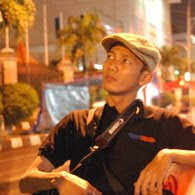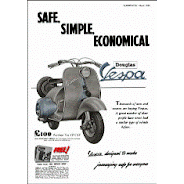LAMBRETTA SCOOTER 1952 - 1999

1952 "D" 125cc
Rod operated rear brake. front suspension springs with fork legs.
Torsion bar suspension, swinging engine unit. Air cooled. No rear damper.
Extra lug to torsion bar link lug on crankcase, for unknown damping systems.
Rounded corners to leg shields. Shaft driven.

1953 "D" 125
As previous "D" but without extra lug on crankcase.
Cable rear brake. Grab handle fitted to pillion seat. No rear damper.

1953 "LD" 125
As "D" but dressed with legshield and sidepanels. Side panels now fitted with white plastic grills and
the clutch and brake levers. Fan cooled. Ducting of polished aluminium pressings. Handle fitted to pillion seat.
LDA self starter model. 6v electrical system. Batteries fitted inside side panels.
1953-4 "E" MODEL, 123cc
Leading link forks. Single tube "C" shaped frame culminating in tool box under seat.
Swivelling front headlight. Hand cord pull start. Leg shield sweeping back each side of totally
redesigned "In Line" engine. Air cooled. Fuel cap fitted to opposite side to "D" models.
1953-4 "F" MODEL
All mechanics as "E" with exception of kickstart operating across the engine.
Torsion bar suspension without damping.
1954 "D" 150cc
Capacity now increased to 150cc. Twin cables on gear change. Rear damper now fitted as standard
with recess in transmission casting for fixing. Lockable lunch box. new shaped air filter.

1954 "LD" 150
The first of the LD's 150cc. Frame spine enlarged dispensing with tubular frame beneath steel pressing.
Larger side panels - no hatchway. Choke control and petrol tap mounted on top of bodywork either side
of central fuel filter and between seats. Glove compartment fitted to house speedo and provision for clock.
Aluminium clamp to handlebars with plastic sheathed cables. Chrome expansion box to silencer.
Pressed steel cowling or ducting to engine painted in silver or colour of bike.
Some deluxe models were named "Mayfair" and "Riviera".

1955 "D" MODEL, 150cc
Fitted with expansion box, as LD - the chromed "Coffee Pot"
Forced air fan cooling. Large front brake. Rear damper unit fitted to lug cast on engine casing.
1955-56 "LD"
As previous LD 150 but with various small mechanical modifications.
Silencer now altered and chromed "Coffee Pot" dispensed with.
LDA Starter model 12 volt system with hump for housing batteries beneath pillion seat.
Kick starter also fitted to this model.

1957 "D" 150
Re-introduced by popular demand, and now supplied with rectifier, battery for 6v lighting
and long tailpipe exhaust.

1957-8 LD Mk 111 125cc
Cowled handlebars housing speedo and horn. Small boot in rear bodywork and re-designed
rear light. Epicyclic kickstart mechanism. Aluminium floor strips and machine finished in light grey
as standard. Chromed side panel grills.

1957-58 LDA 150 Mk 111 150cc.
Horn position moved into cowled handle bars with speedo.
New double action epicycle Kickstart. Rear boot, new design rear light.
Offered as standard in a variety of two-tone colours.
Rubber floor strips. Battery lighting.

1957-58 LDB 150 Mk. 111 AVV.
All as LDA but in self starter version. no Kickstart as on previous LDB's.
Features are the hump to house 12v system batteries.
Blanking plate on crankcase where kickstart was previously housed.
Old style glove box for ampere meter and clock (extras) and starter switch unit.
Long tailpipe version.

1958 TV SERIES 1.
The "Flagship" of Lambretta.
Entirely new concept in design. Biggest capacity yet. 350 x 10" Wheels.
Dual seat. Floor mats. Cast handlebars with integral speedo. Cable adjusters to clutch and front brake.
Fixed front mudguard. Horizontal engine, chain drive with gearbox rear axle.
Coil sprung kickstart unit. No cutaway in side panel for central position kickstart.
Various versions of this model, as production progressed.

1958 Li 125/150 SERIES 1.
Engine different again from the TV version.
This engine design set the pattern for all subsequent future models.
The Li Series 1 was manufactured in 125cc and 150cc versions.
Early machines known as frame breathers, as the air filter drew air through grille on rear body work,
which was eventually replaced by a air filter box between the toolbox and petrol tank.
Looks much like the TV 1 but with no front fork dampers.
Kickstart set well to the rear of the engine. Fitted with separate seats.

1959 Li 125/150 SERIES 11.
This machine was identical to the series 1 except for headlight repositioned into the handle bar casing.
Both in 125cc and 150cc versions. Later models had larger rear light unit.
"Pear Shaped" horn cover. Separate seats.

1960-61 TV 175 11.
The updated 175cc model was basically the Li in 175cc form.
this brought it inline with the other newer models.
Dual seat fitted as standard with key ignition and front dampers.

1962-3 TV 175 111.
All machines now basically the same, with only little cosmetic and internal differences.
The design differences in body work will be apparent from the illustrations.
Engine details, gear ratios and other technicalities are fully covered in the Lambretta workshop manuals.

1962 Li 150 (SLIMSTYLE) SERIES 111.
This replaced the Series 11 models in 1962 and were of squarer appearance
and much narrower in frontal design. A more efficient design of silencer fitted.

1963 Li 150 PACEMAKER.
Body work design differences with flashes on side panels and the now famous "Three penny" bit shaped headset.
All machines from now on feature the dual seat as standard with exceptions in the lightweight Lambrettas.
Versions were available as "Gold" or "Silver" Specials.

1963 TV 175 and later the TV200
The first ever motorcycle to be fitted with front disc brake.
This could have been designated the Series 1V,
but it was soon replaced with a TV 200cc version for the British market.

1964 G.T. 200.
Previously the TV200.
This machine was manufactured due to demand from the British market and was only available in the UK.
Eventually the TV200, due to world wide pressure was produced for distribution in all countries and renamed the GT 200.
Top speed of 70 m.p.h., Smooth braking low fuel consumption and had more to offer than any other scooter in the world.

1964 SX150.
Almost identical to the Pacemaker with similar design features.
Faster due to minor engine modifications.
1964 J50.
This small 50cc machine was produced with a monocoque all pressed steel body.
Fitted as a single seat scooter, a pillion seat was available.
No speedo was fitted or floor strips. An austere model.

1964 "CENTO".
This three speed lightweight of 98cc was very popular.
Body was similar to the J50. Fitted with speedo, floor strips and dual seat.

The 125cc version of the Cento

1966 125 STARSTREAM.
Alternative in design to rear of body work and shape of the rear light.
Now fitted with four speed gearbox.

1967 SUPER STARSTREAM.
Same styling as previous model four speed gearbox.
Fitted with dual seat. Turning front mudguard. Reshaped leg shield.
Larger headlight, false horn casting and no handles to side panels.

Redesigned side panels with "Arrow" flash with 200 emblem.
Mechanical improvements.

1968 VEGA 75.
The arrival of the Luna Line designed by Bertone, the world famous car designer.
75cc with engine layout similar to previous J Model - Open frame - no covering bodywork.

1968 COMETA 75.
Exactly the same machine as the Vega, but fitted with oil pump for separate oil lubrication.

A single seat version of Vega of 50cc.
An economy model with under engine silencer, tubular handlebars and separate headlight.

1968 LUNA CL
A more luxury appointed 50cc single seat.
Same girder type handlebars as Vega with integral headlamp.
Rear light fixed to body work not on a bracket as others in the range.
1969 GP125/150.
These Bertone designed Lambrettas featured many improvements with square headlight,
new type rear light, redesigned dual seat and cutaway front mudguard.
The 125 version was first known as the DL, but changed to GP in 1970.
No front dampers and normal type shoe brakes.

1969-71 GP200.
Front suspension dampers and disc brake.
The last scooter built by Innocenti. Several engine improvements, with the last of production models
having electronic ignition.
In the seventies the Spanish produced their Servetta versions of the Li,s and SX. Some models had indicators
fitted with minor alterations to the electrics / body work and air intake via the toolbox.

In the Eighties and Nineties the GP models were manufactured in India, also with minor alterations. Some had indicators or Mirrors.


















































